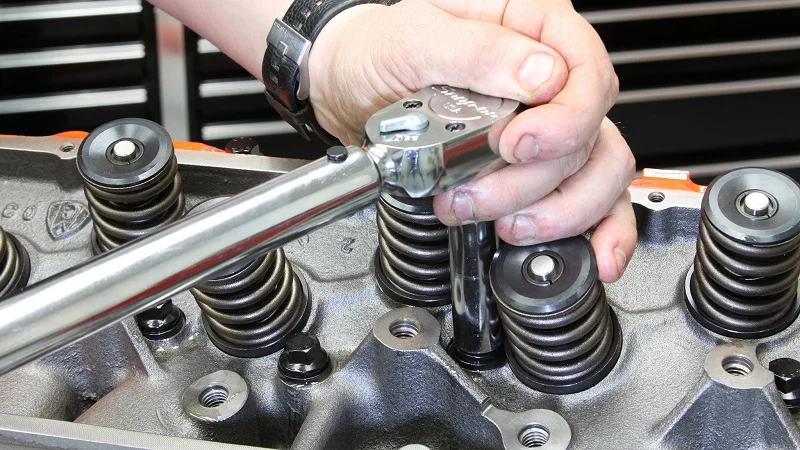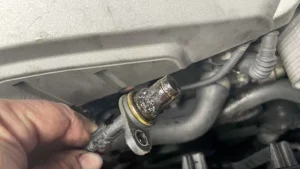
Understanding Cylinder Head Torque
Cylinder head torque refers to the rotational force applied to the cylinder head bolts during installation. The cylinder head sits atop the engine block, sealing the combustion chamber and ensuring that the engine operates efficiently under high pressure and temperature conditions. Proper torque ensures that the head gasket is compressed evenly, maintaining a secure seal between the cylinder head and engine block.
Torque is measured in units of force multiplied by distance, such as Newton-meters (Nm) or foot-pounds (ft-lb). Applying the correct torque requires both accuracy and the correct sequence, as uneven or excessive torque can distort the cylinder head, damage the gasket, or lead to uneven pressure distribution across the combustion chamber.
Why Cylinder Head Torque Is Critical in High-Performance Engines
High-performance engines operate under extreme conditions. They typically generate higher combustion pressures, higher RPMs, and increased heat compared to standard engines. These factors make precise cylinder head torque essential for several reasons:
1. Preventing Head Gasket Failure
- Under-torqued bolts: Insufficient torque allows gaps between the cylinder head and engine block, which can cause leakage of combustion gases or coolant, resulting in reduced performance and potential overheating.
- Over-torqued bolts: Excessive torque can crush the gasket material or distort the cylinder head, leading to premature gasket failure.
In high-performance engines, where combustion pressures are higher, even a small deviation from the recommended torque can compromise the gasket’s integrity.
2. Maintaining Compression Consistency
- Uneven compression ratios
- Misfires in one or more cylinders
- Reduced power output and efficiency
High-performance engines rely on precise compression to maximize horsepower and torque. Correct torque ensures uniform pressure distribution and consistent combustion in every cylinder.
3. Preventing Cylinder Head Warping
- Warping of the cylinder head
- Distorted valve seats and guides
- Poor sealing between head and gasket
Even minor warping can compromise engine performance and longevity, making correct torque indispensable in high-performance applications.
Factors Influencing Cylinder Head Torque
Achieving the correct cylinder head torque is not a one-size-fits-all process. Several factors must be considered:
1. Bolt Material and Condition
Cylinder head bolts can be made from different materials, such as steel or high-strength alloys. Some bolts are torque-to-yield, meaning they are stretched to their elastic limit during installation. Using old or reused bolts can affect the torque outcome because fatigued bolts may not provide uniform clamping force. Always follow manufacturer recommendations regarding bolt reuse and replacement.
2. Lubrication
Lubricating the threads and bolt heads with the appropriate oil or assembly lube is essential. Dry bolts or inappropriate lubricants can result in incorrect torque readings due to friction variability. In high-performance engines, even a small deviation can affect cylinder head clamping force.
3. Torque Sequence
The sequence in which bolts are tightened is critical. Most engines use a crisscross pattern starting from the center bolts and moving outward. This ensures that the cylinder head is seated evenly and prevents distortion. Following the correct sequence reduces the risk of uneven torque and head warping.
4. Engine Temperature
Some high-performance engine builders recommend torquing bolts when the engine is at a specific temperature. Thermal expansion can affect torque readings, and certain engines require bolt retorquing after initial heat cycles. Always refer to the manufacturer’s guidelines for high-performance engines.
Tools and Techniques for Accurate Torque Application
Precision is key when applying cylinder head torque. Using the correct tools and techniques ensures consistent results:
1. Torque Wrenches
A high-quality torque wrench is essential. Digital or beam torque wrenches provide accuracy, while click-type wrenches give tactile feedback. For high-performance engines, a digital torque wrench can help achieve exact torque values with minimal error.
2. Torque Angle Method
Some modern engines specify torque values in combination with a torque angle method, especially for torque-to-yield bolts. This method involves tightening the bolts to an initial torque and then rotating them an additional specific angle to achieve the correct stretch. This method ensures consistent clamping force across all bolts.
3. Sequential Tightening
- Hand-tighten all bolts
- Apply a first stage of torque (e.g., 30% of final value)
- Apply the final torque in multiple stages
- For torque-to-yield bolts, apply the specified additional rotation
Following these steps ensures the cylinder head is evenly clamped and reduces the risk of warping or gasket failure.
Common Mistakes and Their Consequences
- Skipping the torque sequence: Leads to uneven pressure and potential warping.
- Over-tightening bolts: Risks snapping bolts or crushing gaskets.
- Under-tightening bolts: Can cause leaks, low compression, and poor performance.
- Reusing torque-to-yield bolts: Stretched bolts lose clamping force and can fail prematurely.
- Neglecting lubrication: Affects torque accuracy and clamping force distribution.
High-performance engines amplify these mistakes because of the increased pressures and RPMs. Small errors that might be tolerated in standard engines can cause catastrophic failure in performance applications.
Best Practices for High-Performance Cylinder Head Torque
- Always use new bolts if specified by the manufacturer, especially for torque-to-yield designs.
- Follow the recommended torque sequence and stages.
- Use the correct lubrication on threads and bolt heads.
- Verify torque settings with a calibrated torque wrench.
- Consider retorquing after initial engine heat cycles if recommended by the engine manufacturer.
- Document torque settings and sequence for future maintenance or troubleshooting.
Implementing these practices reduces the risk of engine damage, improves reliability, and ensures consistent performance in high-performance applications.
The Impact on Engine Longevity and Performance
- Enhanced engine efficiency: Uniform compression improves fuel combustion and power output.
- Reduced risk of leaks: Coolant, oil, and combustion gases are sealed effectively.
- Extended component lifespan: Head warping, gasket failure, and valve seat damage are minimized.
- Improved reliability under stress: High RPM and high-pressure engines withstand extreme conditions.
For high-performance enthusiasts and professional engine builders, meticulous attention to cylinder head torque is not optional; it is essential.
Conclusion
Cylinder head torque is a critical yet sometimes underestimated aspect of high-performance engine assembly and maintenance. Correct torque application ensures proper sealing, uniform compression, and structural integrity of the cylinder head and gasket. For engines operating under high stress, even small deviations from the recommended torque can compromise performance, reliability, and longevity. By understanding the principles behind cylinder head torque, following manufacturer specifications, and using precise tools and techniques, engine builders can achieve optimal performance and durability.
High-performance engines demand precision at every step, and cylinder head torque is a perfect example of how attention to detail can make the difference between an engine that delivers maximum power and one that suffers premature failure. Properly torqued cylinder heads not only protect critical engine components but also unlock the true potential of a high-performance engine.



